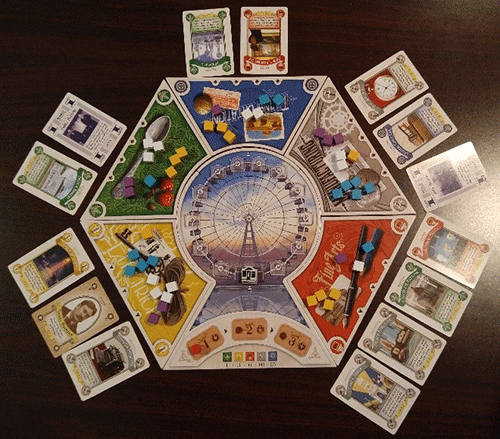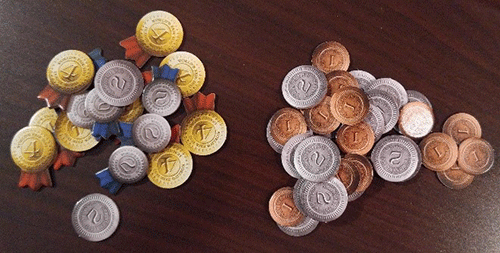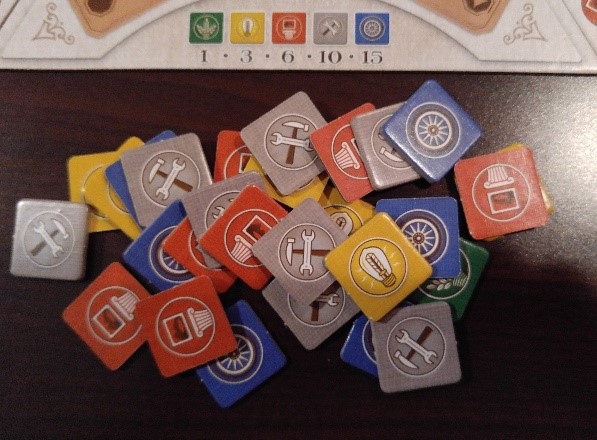World's Fair 1893 Review
on Jun 29, 2016
The year is 1893 and you’re in Chicago. Wrigley’s gum, the zipper, and the Ferris wheel (originally an attempt to outdo the Eiffel Tower) are all making their debut. These are exciting times and there is a lot to see. And this is exactly what you’ll be doing in a game of World’s Fair 1893.
Although the setting game is pretty thin, the fact that it’s novel helps to compensate for it. Plus, the amount of research that went into flavoring the game is obvious. I was impressed that every single card has a unique illustration with a snippet of information on it. I didn’t even realize it was my turn because I was too busy reading about the 11-ton Cheese Exhibit. That’s right; 22,000 pounds of cheese. (I may or may not have spent a good deal of time online fact-checking this exhibit.) When out on the table, the game instantly draws you in with its bright and colorful artwork.

Don’t let the fact that World’s Fair 1893 is a 2016 Mensa Select Winner mislead you; it’s actually a relatively light weight and easy game to learn, making it a great fit for families and/or casual gamers. In fact, the rules are short and easy to explain and gameplay is relatively short at a filler-length 30-45 minutes. There’s a little variety in the modular exhibit areas so there is built-in replayability.
Now I know the phrase “elegant design†is overused, but it really does apply here. On your turn, you put one of your supporters cubes in one of the five areas that represent exhibits, use any influential figures (action cards) you have, then pick up the cards from that area. That’s it. Despite this simplicity, there are decisions to be made that often hinge on the timing of the end-of-round scoring, which ends once the Ferris wheel car makes a full rotation.
At first, it seems like placing on the areas with more cards would be better, but this is not always the case. You want to carefully position your supporters so as to edge out your opponents for majority. Plus, those influential figures may push you toward making clever moves where you can plop down another supporter in the same area or move an opponent’s supporter to another spot. Once end-of-round scoring happens, you count up your midway tickets and turn in any exhibit proposal cards that match the area(s) you have majority in for tokens that score points at the end of the game. This incentivizes you to not always maintain your majority in one area, making the positioning on the board fairly dynamic. After three rounds, whoever has the most points is the king/queen of the fair! Well, not really. You’re just the winner, but that’s pretty cool too.

One of the problems with the game is that it’s hard to feel like you have much control over the board. While you may be working hard to build up certain sets of cards, there’s no guarantee that you’ll be able to turn those in for tiles, which will earn you points at the end of the game. This means your efforts to collect a lot of cards may not payoff and that just doesn’t feel good. As you move through a game of World’s Fair 1893 and get some experience, it does become easier to see how to manipulate your supporters or select cards to your advantage. However, as mentioned above, more cards do not necessarily mean you’re doing better than others.

Like other area majority games, World’s Fair 1893 may be less about coming in first in a few different areas and more about taking a bunch of second places for a steadier income of tokens. Still, some gamers may find that the amount of control and strategy that they want in a game is limited and this game may not offer the complexity they are looking for. All in all, World’s Fair 1893 is an enjoyable, but not particularly standout game. Its biggest flaw is that in a sea of excellent games, it likely won’t wow or impress anyone. However, if you’re looking for an approachable, relatively quick area majority game, I do think this is worth taking a further look at.

 Customer Support
Customer Support  Subscribe
Subscribe 




 Account
Account  Wishlist
Wishlist 
